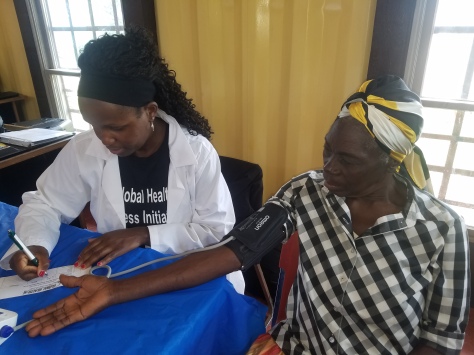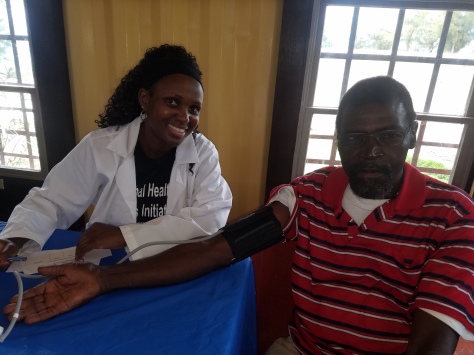Our Haiti global health fitness mission went very well. Haiti occupies the western third of the Caribbean island of Hispaniola, sharing a border with the Dominican Republic. Over 10 million people live in Haiti with a large portion of its population being young people, in part because of a high birthrate and shorter life expectancy. 37% of Haitians are younger than 14, 59% are between 15 and 64 years old, and just 3% are 65 and older.

Our global health fitness mission to Haiti focused on non-communicable disease prevention through health and wellness biometric screenings and counselling and physical activities such as Zumba dance fitness class. We partnered with the YMCA D’Haiti / YMCA of Haiti to offer free health and fitness services. YMCA d’ Haiti is a community-based organization committed to building spirit, mind and body. The organization develops youth, teens and adults through education and character building programs, to help them become leaders in creating a stronger community in Haiti.
Watch the video below to learn more about the work of the Haiti YMCA and what they consider to be Haiti’s biggest health challenges.
During this trip, we were only able to perform a few biometric screenings due to limited supplies and human resources. We were able to take blood pressure readings, body composition measurements which include height, weight and body fat. We also gave health advice based on the person’s screening results.
Based on our health screening results and general observation, some Haitians were under weight, while some of them were within their healthy weight based on age and height. The younger people had a normal blood pressure. However, most of those those above 30 and the elderly had high blood pressure, mostly due to blood pressure. High blood pressure is a silent killer and most people have no clue if they are a walking time bomb until they get regular health screenings and get the right treatment or medication to contain it. Unfortunately, most of the people we saw don’t have adequate access to health care, especially the elderly who are on blood pressure medication but go months without refills because they don’t have the money to refill their prescriptions and they don’t have transportation to take them to get their medications.


Haiti’s Health Profile:
Haiti reports some of the world’s worst health indicators, which continue to inhibit the country’s development. The problem with healthcare in Haiti it is almost nonexistent. There’s no system, structure or plan that has been implemented. What healthcare facilities that exist are not adequate. There’s insufficient medical staff, support staff, equipment and treatment. The little healthcare system that Haiti has depends heavily on medical NGOs such as MSF, the Cuban Brigade and a few faith-based and charity clinics to fill the void. Haiti needs a permanent, modern health care infrastructure that can respond to the medical needs of all Haitians and one that is organized and staffed mostly by Haitians.
Environmental health wise, Haiti suffers from a deforestation problem which partly contributes to its devastating natural disasters. With oil being too expensive to the average person, charcoal from burnt trees has provided 85% or more of the energy in Haiti for decades. Despite the Haitian government discouraging its citizens against deforestation, Haitians have relentlessly hunted and chopped down huge amounts of forest. In the past couple of decades, the US Agency for International Development (USAID) planted over 60 million trees. However, an estimated 10 to 20 million of these are cut down each year.
Although Haiti didn’t have much of a healthcare structure to destroy, the earthquake of January 12, 2010 caused damage to the health care infrastructure in Port-au-Prince and shut down basic services critical. A few months after the earthquake, Haiti’s health care network was further strained by the country’s first cholera outbreak in a century. Cholera is an acute dehydrating bacterial infection spread through water and food contaminated by human faeces. The illness is exacerbated by heavy rains, poor sanitation, and limited clean water, and associated poor hygiene, such as failure to wash hands after going to the toilet. Treatment for most people is through oral rehydration and, in severe cases, an intravenous rehydration with antibiotics.

Key Challenges to Haiti’s Health status include:
A weak health system: Roughly 40 percent of the population lack access to essential health and nutrition services; only 45 percent of all children (12-23 months) are fully vaccinated and 22 percent of children under 5 years old are stunted.
Funding environment: Government spending for health is low and only represents 6 percent of all government expenditure for the country. There is still heavy reliance on international funding to provide Haitians access to health care services.
Human resources for health: Attracting and retaining qualified health professionals is a chronic struggle, with as few as six health professionals per 10,000 people.
Health infrastructure: The destruction created by the 2010 earthquake and Hurricane Matthew exacerbated an existing lack of adequate health infrastructure, such as health care and storage facilities, as well as access to electricity, clean water and sanitation systems.
According to CDC, Haiti Top 10 Causes of Death are:
Cardiovascular Diseases
Diarrhea/LRI/Other
Neoplasms
HIV/AIDS & Tuberculosis
Diabetes/Urog/Blood/Endocrine Diseases
Neonatal Disorders
Unintentional Injuries
Chronic Respiratory Diseases
Transport Injuries
Other Non-Communicable Diseases
——————————————————————————————————-


